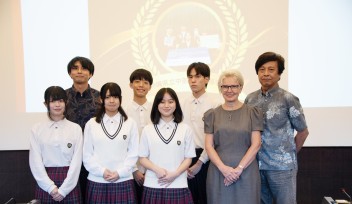Creating synergy across generations at the OIST-Keio summer camp

The Okinawa Institute of Science and Technology (OIST) and Keio University have long enjoyed a fruitful and mutually beneficial relationship. One of the initiatives from this collaboration is the yearly OIST-Keio International Research Summer Camp, where medical students from Keio University gain first-hand experience with fundamental research in an international setting.
The ten-day summer camp, which is now in its third iteration, sees the students join one of the 80+ research units at OIST, where they contribute directly to lab research, working closely with professors, researchers and graduate students. The Keio students also participate in various scientific, recreational and cultural activities in and around the OIST campus, such as coral planting excursions, taking classes in Okinawan language and history, or attending workshops on academic English or on how to play the sanshin. The initiative is generously supported by Tatsuo Kawasaki, a member of OIST’s Board of Councilors, whose contributions ensure that the camp can offer an enriching experience to help foster the next generation of scientists.

This year, 20 students from the Keio School of Medicine joined a host of labs in various disciplines, from cell function, over computational neuroscience, to marine ecology, and got to experience real-life research up close. As one of the students remarked, they learned that “research involves lots of learning, struggles and thinking. I’ve also got good advice and insight on my future career,” whereas another said that the experience “motivated me a lot toward my future research.”
On the other hand, the supervisors also gained fresh perspectives on their research, and working with undergraduate students gave valuable insights into mentoring practices and research design. As one of them remarked, “it was a pleasure to work with the students and see their curiosity grow. The camp allowed me to improve my mentoring approach, and I believe it was a mutually beneficial experience."

On top of the research experience, the students also got a unique chance to experience a multicultural campus environment with researchers and staff coming from many different backgrounds. As such, the students got to train and practice their conversational and academic English through OIST-run English classes and a variety of social events like flash talks or speed-networking with PhD students and staff, as well as many other workshops and events. To many of the students, this multicultural setting was an eyeopener: “I loved the environment, being able to use my English and interact with many researchers from across the world,” says one, whereas another highlights how the social events “made me more confident in my English-speaking skills. I had many opportunities to talk with many people from various countries.”

For 85% of Keio students joining the camp, the hands-on experience in an international research environment doesn’t stop at the conclusion of the ten-day experience, as they later come back to OIST through the research internship program. One camper, who later rejoined OIST as an intern, co-authored a paper on organic chemistry with members of the pi-Conjugated Polymers Unit that was recently published in the journal Organic Letters.
Looking ahead, the collaboration between Keio and OIST is set to expand with the pilot program Keio-OIST Clinical Research Partnership. Through this, OIST researchers will take up residence at Keio University’s School of Medicine, creating further robust opportunities for synergy, innovation and research in medicine and other fields.
This program was partially supported by Japan’s Ministry of Education, Culture, Sports, Science and Technology’s (MEXT) program for “Forming Japan’s Peak Research Universities” (J-PEAKS).
For press enquiries:
Press Inquiry Form














